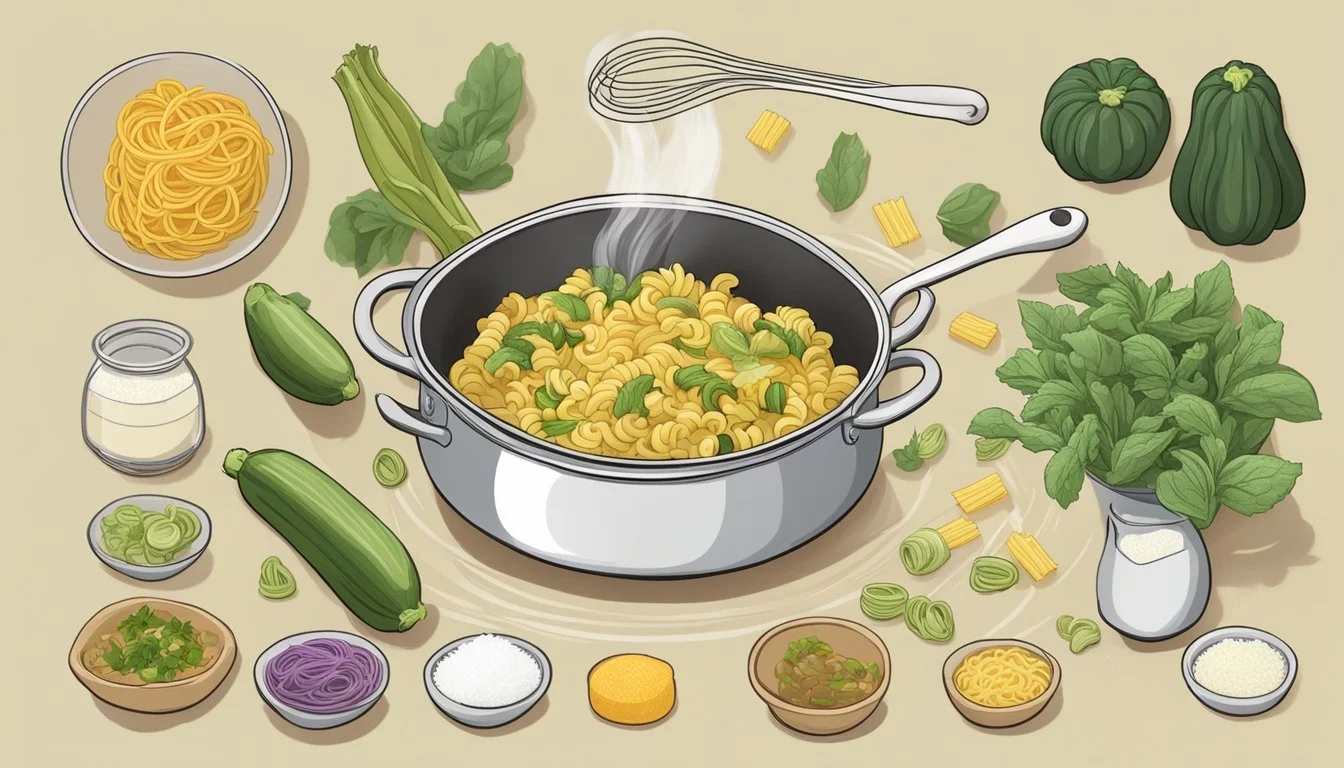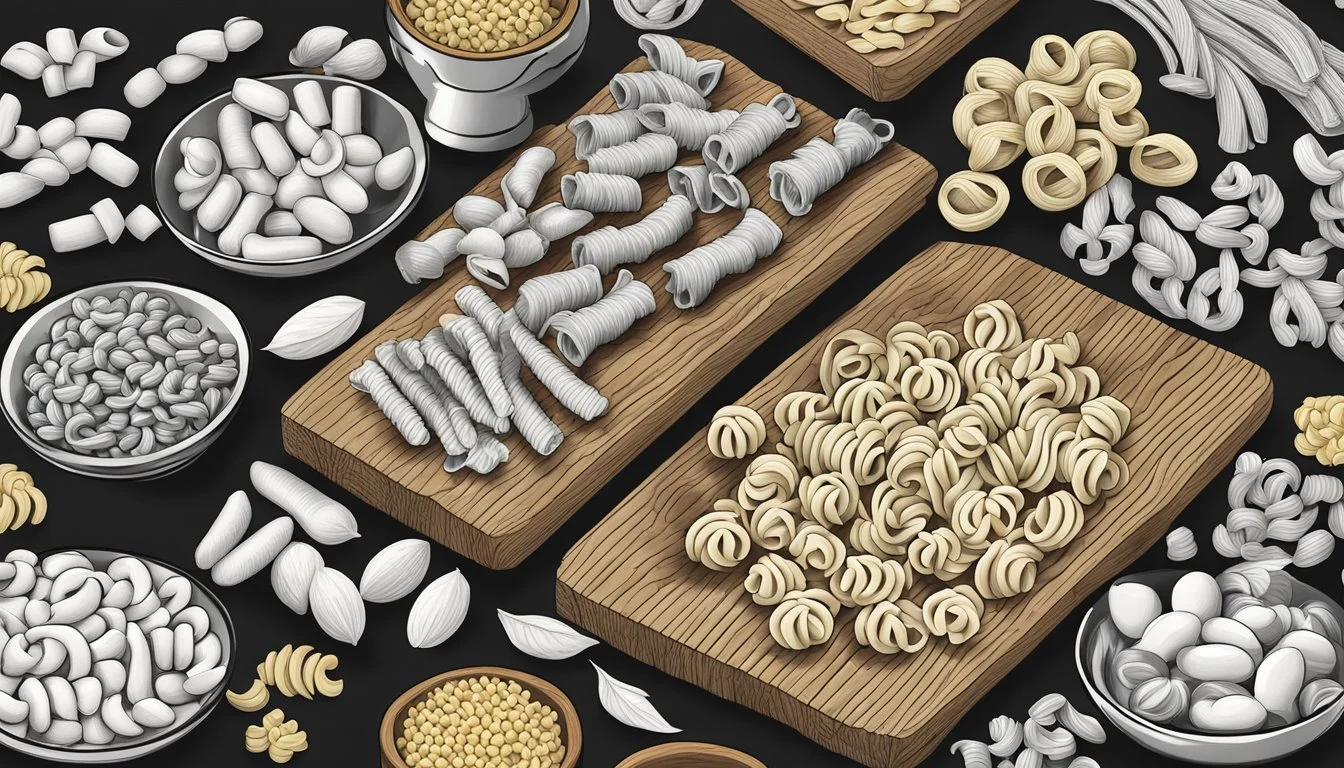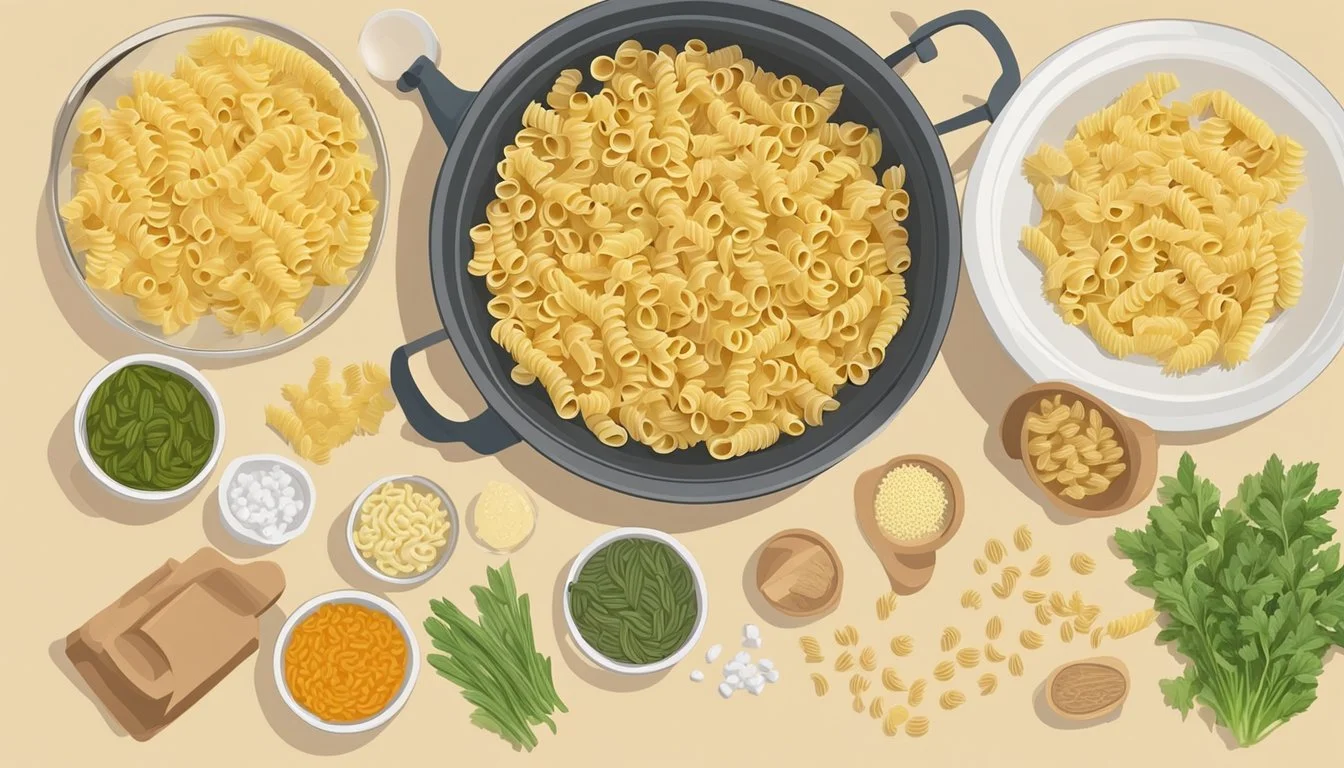Cavatappi Pasta Substitutes
Top Alternatives for Your Favorite Dishes
Cavatappi pasta is a popular ingredient in many culinary preparations due to its distinctive corkscrew shape that makes it exceptional for holding onto sauces and providing a satisfying texture. It is widely appreciated for its versatility in the kitchen, making it a staple in the pantries of both home cooks and professional chefs alike. Occasionally, however, one might find themselves without this helical pasta (What wine goes well with pasta?) on hand, prompting the need for suitable alternatives that preserve the integrity of the dish being prepared.
Exploring substitutes for cavatappi pasta, it is essential to consider the shape, texture, and size of the alternatives to ensure that they complement the sauce and other components of the recipe. Options such as penne, with its tube-like structure, offer a good foundation for more substantial sauces, while farfalle, recognized for its bow-tie appearance, can introduce an element of visual appeal alongside its functional sauce-trapping ability. Both of these options, alongside others like fusilli and macaroni, provide cooks with the opportunity to maintain the essence of their dish even in the absence of cavatappi.
When selecting a substitute for cavatappi, it is important to consider the cooking times and the way the pasta interacts with the chosen sauce. Some variants may have ridges or be slightly more curved, which can affect how the sauce clings to the pasta. Understanding these nuances can be the difference between an average meal and a delightful culinary experience that echoes the intended charm of a recipe designed for cavatappi pasta.
Understanding Cavatappi Pasta
Cavatappi pasta is a distinctive noodle variety celebrated for its unique shape and versatility in dishes. This section will explore its defining attributes and culinary applications.
Characteristics of Cavatappi
Cavatappi pasta exhibits a helical, corkscrew shape that makes it stand out in an array of pasta types. This unique form provides not only aesthetic appeal but also a functional benefit: the ridges and spirals are excellent for trapping and holding sauces. Made from durum wheat, Cavatappi maintains a firm texture after cooking, contributing to its satisfying mouthfeel.
Shape: Helical corkscrew
Texture: Firm with ridges
Material: Durum wheat
Common Uses in Dishes
Cavatappi is traditionally incorporated in various dishes where its robustness complements hearty ingredients. It is a popular choice for pasta salads, as the grooves capture dressings and small bits of vegetables or cheese, enhancing the flavor in every bite. In casseroles, Cavatappi provides structural integrity and an engaging texture that withstands baking and melds well with cheeses and meats.
Pasta Salad: Ideal for trapping dressings and mix-ins
Casseroles: Maintains integrity and pairs well with creamy textures
Reasons for Substituting Cavatappi Pasta
When considering replacing cavatappi pasta in a recipe, individuals look for alternatives due to dietary necessities, taste preference, or the ease of finding a substitute.
Dietary Restrictions
For individuals with dietary restrictions, gluten-free options replace traditional cavatappi pasta made from durum wheat. Rice or quinoa (What wine goes well with quinoa?) -based pastas are commonly sought after for their gluten-free qualities, allowing for a similar culinary experience without the presence of gluten.
Texture and Flavor Preferences
Some may seek a different texture or flavor from their pasta. For instance, substitutes like whole wheat pasta can offer a more robust flavor profile and a denser, heartier texture compared to the lighter, more tender bite of cavatappi.
Availability Issues
The availability of cavatappi at a local grocery store can influence a person's decision to find an alternative. Fusilli and macaroni are good substitutes for cavatappi because their shapes are conducive to holding sauces, and they are more likely to be found on shelves at local stores.
Alternate Pasta Shapes and Types
When seeking alternatives to cavatappi pasta, one should consider the pasta's shape, size, and texture compatibility with the intended dish.
Short Tubular Pastas
Short tubular pastas make excellent substitutes for cavatappi due to their similar size and capability to hold sauces. Penne and macaroni are prime examples:
Penne: Characterized by its tube-like shape with angled ends, penne is ideal for rich sauces.
Macaroni: Commonly used in mac and cheese, its small hollow shape pairs well with cheese sauces.
Spiral Pasta Varieties
Spiral pasta varieties, such as fusilli and rotini, are shaped like corkscrews and adept at trapping and holding sauces:
Fusilli: With its twisted shape, fusilli grips onto thicker sauces, making it a flavorsome stand-in for cavatappi.
Rotini: Slightly larger spirals compared to fusilli, rotini's grooves are excellent for lighter or chunky sauces.
Unique and Novelty Pasta Shapes
These pasta shapes add a playful element to dishes while maintaining functionality:
Farfalle: Known as "butterfly" or "bow-tie" pasta, farfalle's pinched middle makes it a whimsical substitute.
Rigatoni: This pasta boasts a broad, cylindrical shape with ridges, perfect for holding onto hearty sauces.
In summary, a variety of pasta shapes like penne, fusilli, and rigatoni serve as functional and delightful stand-ins for cavatappi, ensuring that the pasta experience is never compromised.
Alternative Pastas for Specific Dishes
When substituting cavatappi in recipes, it is essential to consider the type of dish to maintain texture and sauce integration. Each substitute is selected based on its ability to complement the characteristics of specific pasta dishes (What wine goes well with pasta dishes?).
Pasta Salads and Cold Dishes
For pasta salads and cold dishes, a pasta that holds dressing well and remains firm is ideal. Fusilli, with its corkscrew shape similar to cavatappi, is excellent for trapping dressings and maintaining structure, even when served cold. Use a list-like table format, for clarity:
Pasta Salad/Cold Dish Recommended Substitute Classic Pasta Salad Fusilli Mediterranean Salad Rotini Cold Pasta with Pesto Gemelli
Hearty and Baked Pasta Dishes
Hearty and baked pasta dishes, such as lasagna or baked ziti, need substitutes that can hold up to baking and carry rich, hearty sauces.
Rigatoni with its large tubes and ridges is suitable for holding meat sauces and is sturdy enough for layering in baked dishes.
For a mac and cheese with a twist, macaroni is a practical substitute, particularly elbow macaroni, due to its slight curve which captures creamy sauces.
Pasta Dishes with Creamy or Heavy Sauces
When preparing dishes with creamy or heavy sauces, such as Alfredo or carbonara, the pasta's surface and shape are crucial for sauce adhesion.
Shells or conchiglie can scoop up generous amounts of sauce, making each bite flavorful.
Penne, with its tube-like shape and ridges, is also an appropriate choice for creamy sauces, ensuring a good balance of pasta to sauce in every bite.
Considering Non-Pasta Substitutes
In exploring alternatives to cavatappi pasta, one might consider various grains and cereals as well as vegetable-based options that cater to gluten-free diets and provide ample protein and fiber.
Grain and Cereal Alternatives
Grains and cereals can serve as filling and nutritious substitutes for traditional pasta. Two notable choices are:
Rice: It offers a neutral base similar to plain pasta, and can effectively absorb flavors from sauces and seasonings. Rice is also gluten-free, making it suitable for those with dietary restrictions.
Quinoa: This grain provides a substantial amount of protein and fiber. Quinoa's slightly nutty taste and hearty texture can complement dishes commonly made with cavatappi, while also being a gluten-free alternative.
Vegetable-based and Gluten-free Options
For those seeking gluten-free alternatives or wanting to increase their vegetable intake, the following options can substitute for pasta:
Corn: Gluten-free and a good source of fiber, corn can be transformed into polenta or used in the form of corn pasta, which mimics traditional pasta shapes and textures.
Vegetables: Many vegetables can be spiralized or cut into shapes that mimic the twists and turns of cavatappi. Options like zucchini noodles, also known as "zoodles," offer a low-calorie, nutrient-rich pasta alternative that's rich in fiber. Other vegetables such as spaghetti squash naturally separate into pasta-like strands when cooked and scraped with a fork.
Cooking Tips for Pasta Substitutes
When substituting for cavatappi pasta, it's vital to maintain the integrity of the dish through careful adjustments in cooking time and techniques, as well as thoughtful sauce pairing and seasoning. These modifications help in achieving the right texture and flavor, ensuring a successful pasta meal.
Adjusting Cook Times and Techniques
Different pasta shapes require varied cook times and methods to reach the ideal al dente texture. For instance, substituting fusilli for cavatappi, one should remember that fusilli's spirals may cook faster or slower depending on their thickness relative to cavatappi's hollows.
Fusilli: Typically cooks in 10-12 minutes.
Rigatoni: A robust option with ridges, usually cooks in 12-15 minutes.
Macaroni: Shorter and narrower, might cook in 8-10 minutes.
Cooking pasta in a large pot of boiling, salted water is standard. The water should taste like the sea to bring out the pasta's flavor. To prevent sticking, one can add a splash of olive oil to the water and stir the pasta occasionally.
Sauce Pairing and Seasoning
Choosing the right sauce to complement the substituted pasta is crucial, as it can make or break a dish. Substitutes for cavatappi should be paired with sauces that suit their shape and texture.
For tomato sauce, choose pasta with ridges like rigatoni to hold the sauce better.
Lighter sauces or olive oil based can work well with fusilli, as it has a spiraled surface for the sauce to adhere to.
Creamy sauces, which marry well with cavatappi, might also pair beautifully with macaroni due to its ability to trap sauce inside its hollow shape.
It's also essential to season the pasta water with salt adequately but do not overlook finishing the dish with appropriate herbs and seasoning to tie the flavors together. Freshly grated cheese, a drizzle of high-quality olive oil, or a sprinkle of fresh herbs can elevate the final dish significantly.
Nutritional Considerations
When choosing substitutes for cavatappi pasta, consumers should consider how the alternatives stack up in terms of calories, carbohydrates, protein, and fiber content. Different pasta varieties offer distinct nutritional profiles, often determined by their ingredients such as whole wheat, semolina, or durum wheat flour.
Calorie and Carb Comparisons
Whole Wheat Pasta: It typically contains fewer calories and a lower carbohydrate count compared to traditional pastas made from semolina or durum wheat flour. For instance, a standard serving size of whole wheat pasta may contain approximately 174 calories and 37 grams of carbs.
Semolina/Durum Wheat Pasta: These pastas are higher in calories and carbohydrates. A similar serving size can have up to 220 calories and 42 grams of carbs.
Balancing Protein and Fiber Intake
Protein: Pastas made from durum wheat, including substitutes for cavatappi, are good sources of protein, with an average serving offering around 8 grams. This is essential for muscle repair and growth.
Fiber: Whole wheat pasta variants stand out for their higher fiber content, which can aid in digestion and provide a sense of fullness. One can expect about 6 grams of fiber per serving from whole wheat options, compared to around 2 grams in standard semolina pasta.
Finding Pasta Substitutes at Local Grocery Stores
When searching for pasta substitutes at local grocery stores, shoppers have a variety of options that can stand in for Cavatappi. These alternatives not only maintain the integrity of Italian pasta dishes due to their versatility but also cater to the need for different shapes and textures.
Fusilli and Rotini are excellent choices; both have spiral shapes ideal for holding sauces. They are readily available in the pasta aisle of most stores.
Here's a quick guide to some common substitutions:
Fusilli: Corkscrew-shaped, excellent sauce holder.
Rotini: Similar to fusilli but with larger spirals.
Macaroni: Tubular shape, particularly Elbow Macaroni with its slight curve.
Consider the dish's requirements when selecting a substitute to ensure that the pasta’s texture and sauce-holding capacity align with the recipe’s demands.
For the health-conscious or those with dietary restrictions, many grocery stores offer whole-grain or gluten-free pasta options, providing a diversity of choices. Italian pasta need not be the only go-to, as many stores stock alternatives that suit various tastes and nutritional needs.
When perusing the pasta section, shoppers should keep in mind the differences in cooking times and the ability of each pasta type to complement the other ingredients. The types of pasta mentioned are versatile enough to adapt to a broad range of recipes, ensuring that the essence of the dish remains intact, even when Cavatappi is not available.
Conclusion
When looking for substitutes for Cavatappi pasta, one must consider both the shape and the texture of the alternatives to match the original as closely as possible. Suitable substitutes include:
Penne: Recognized for its cylindrical shape, penne is a hearty option that pairs well with a range of sauces and can be used in both main courses and side dishes.
Farfalle: Also known as bow-tie pasta, farfalle offers an aesthetically pleasing option that adds a playful touch to any dish without compromising on taste.
Rigatoni: With its wide ridges, rigatoni ensures that sauces cling well, making it a well-suited option for robust, creamy sauces that you would typically serve with Cavatappi.
Macaroni: Particularly elbow macaroni, with its curved shape, can serve as a closer textural alternative and is excellent for baked pasta dishes.
Each of these options brings a unique shape and texture to the table. Yet, they all maintain the essential quality of being versatile in accommodating a wide array of flavorful sauces and ingredients, hence ensuring a delectable eating experience. Whether one is preparing a hearty main course or a simple side dish, these substitutes are sure to satisfy both the eye and the palate. They offer a diverse range allowing for creativity and adaptability in the kitchen while staying true to the integrity of the original dish.









